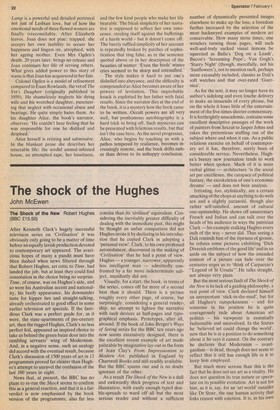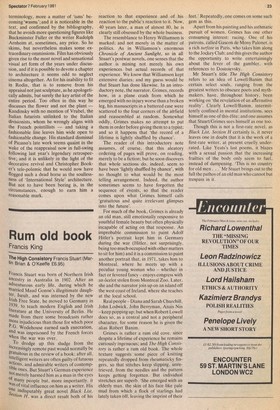The shock of the Hughes
John McEwen
The Shock of the New Robert Hughes (BBC £15.50) After Kenneth Clark's hugely successful television series on 'Civilisation' it was obviously only going to be a matter of time before an equally lavish production devoted to contemporary art appeared. The avaricious hopes of many a pundit must have been dashed when news filtered through that Robert Hughes, art critic to Time, had landed the job, but at least they could find consolation in the choice being no surprise. Time, of course, was on Hughes's side, and so were his Australian accent and nationality, his beefy appearance, his downunder taste for kipper ties and straight-talking, already orchestrated to good effect in some earlier television art specials. If the fastidious Clark was a perfect guide for, as it were, the state-apartments of pre-century art, then the rugged Hughes, Clark's no less perfect foil, appeared an inspired choice to take us behind the green baize door into the rambling servants' wing of Modernism. And, in a negative sense, such an analogy did accord with the eventual result, because Clark's discussion of 1500 years of art in 13 programmes proved far clearer than Hughes's attempt to unravel the confusion of the last 100 years in eight.
News that, at present, the BBC has no plans to re-run the Shock seems to confirm this as a general reaction, and that it is a fair verdict is now emphasised by the book version of the programmes, also far less concise than its 'civilised' equivalent. Considering the inevitably greater difficulty of dealing with the immediate past, this might be thought an unfair comparison did not Hughes invite it by declaring in his introduction that he copied Clark in adopting a 'personal view'. Clark, to his own professed astonishment, discovered in the making of 'Civilisation' that he had a point of view. Hughes — a younger, narrower, apparently less intelligent man — admittedly confronted by a far more indeterminate subject, manifestly did not.
Visually, for a start, the book, in terms of the series, comes off far more of a second best than it should. There is a picture roughly every other page, of course, but surprisingly, considering a general readership, no attempt to lighten the narrative with such devices as half-pages and typographical emphasis. Prototypes, after all, abound. If the book of John Berger's Ways of Seeing series for the BBC ten years ago now seems excessively designed, there is the excellent recent example of art made palatable by imaginative lay-out in the form of Jean Clay's From Impressionism to Modern Art, published in England by Chartwell Books and still readily available. But the BBC spurns one and is no doubt ignorant of the other.
As a result The Shock of the New is a dull and awkwardly thick progress of text and illustration, with easily enough typed double-spreads to ward off all but the most serious reader and without a sufficient number of dynamically presented images elsewhere to make up the loss; a boredom further increased by the selection of the most hackneyed examples of modern art conceivable. How many more times, one wonders turning these pages, will such well-and-truly sucked visual lemons be squeezed as Balla's 'Dog on a Leash', Bacon's 'Screaming Pope', Van Gogh's 'Starry Night' (though, mercifully, not his 'Sunflowers), not to mention such, perhaps more excusably included, classics as Dali's soft watches and that over-rated `Guernica'.
As for the text, it may no longer have its author's sidelong and even louche delivery to make an innuendo of every phrase, but on the whole it loses little of the entertainment of the five-times shorter commentary. It is forthrightly unacademic, contains some excellent descriptive passages of the work of painters from Seurat to Jasper Johns and takes the pretentious stuffing out of the subject where and when it can. As a public relations exercise on behalf of contemporary art it has, therefore, surely been of considerable service. Nevertheless, Hughes's breezy new journalese tends to work better when spoken. Much of it is mere verbal glitter — architecture 'is the social art par excellence, the carapace of political fantasy, the exoskeleton of one's economic dreams' — and does not bear analysis.
Irritating, too, stylistically, are a certain smacking of the chops at anything to do with sex and a slightly paranoid, though also rather self-satisfied,. amount of cultural one-upmanship. He shows off unnecessary French and Italian and can talk over the heads of his audience in ways the patrician Clark — his example stalking Hughes every inch of the way – never did. Thus seeing a Dali reminds him of the ripeness of grouse, he refutes some pictures exhibiting 'Dick Diverish emblems of the good life' and in an aside on the subject of how the intended content of a picture can fade over the centuries urges us to 'think of Carpaccio's "Legend of St Ursula".He talks straight, not always very plain.
But the most serious fault of The Shock of the New is its lack of a guiding philosophy, a real point of view. Clark declared himself an unrepentant 'stick-in-the-mud', but for all Hughes's outspokenness – and for someone in his position he is quite courageously rude about American art politics – his viewpoint is essentially fashionable and uninvolved. In the Sixties he 'believed art could change the world', now that he is in a position to do something about it he says it cannot. On the contrary he declares that Modernism – avantgardism – is dead, though does not seem to reflect that it still has enough life in it to keep him employed.
But much more serious than this is the fact that he does not see art as a vitality. He does not question its true nature or speculate on its possible evolution. Art is not for him, as it is, say, for an 'art world' outsider like Dr Storr, the one human activity that links reason with emotion. It is, in his own terminology, more a matter of 'isms' becoming `wasms'; and it is noticeable in the text, and confirmed by the bibliography, that he avoids more questioning figures like Buckminster Fuller or the writer Rudolph Arnheim at, sometimes, any price. So he skims, but nevertheless makes some extraordinary ommissions. Film has obviously given rise to the most novel and sensational visual art form of the years under discussion, and if it is possible to devote a chapter to architecture it seems odd to neglect cinema altogether. As for his inability to fit in Rodin, that is to remove from his appraisal not just sculpture, as he apologetically admits, but surely the key artist of the entire period. Too often in this way he discusses the flower and not the plant — Kandinsky with no mention of Vrubel, the Italian futurists unlinked to the Italian divisionists, whom he wrongly aligns with the French pointillists — and taking a fashionable line leaves him wide open to fashionable change. His standard dismissal of Picasso's late work seems quaint in the wake of the reappraisal now in full-swing following last year's legendary retrospective; and it is unlikely in the light of the decorative revival and Christopher Booker's tele-polemic that he would now have flogged such a dead horse as the soullessness of 'International Style' architecture. But not to have been boring is, in the circumstances, enough to earn him a reasonable mark.







































 Previous page
Previous page